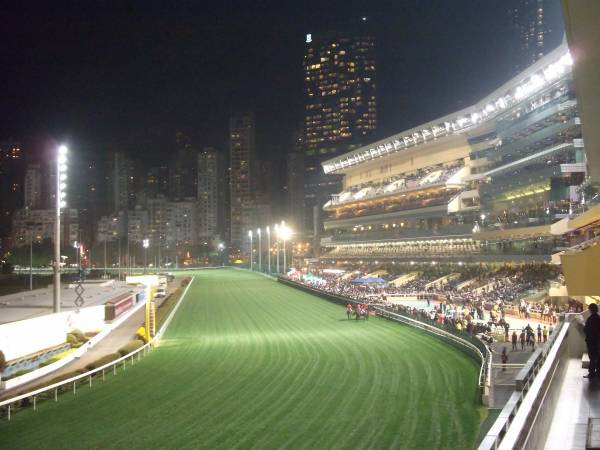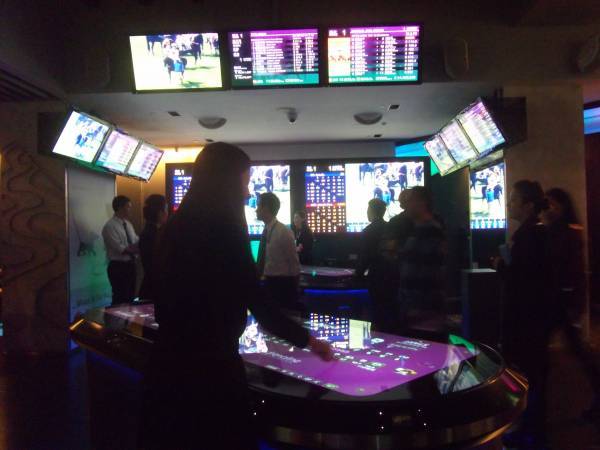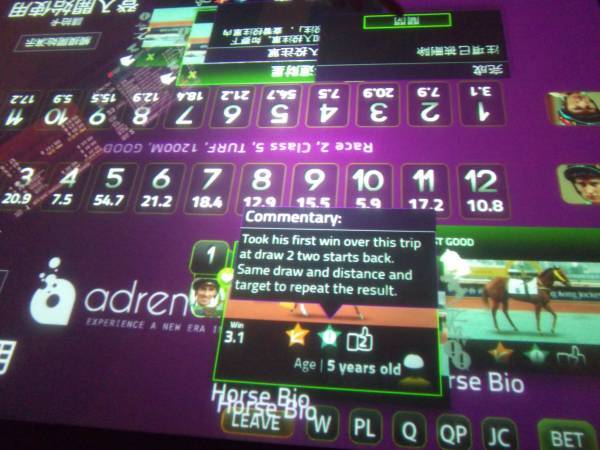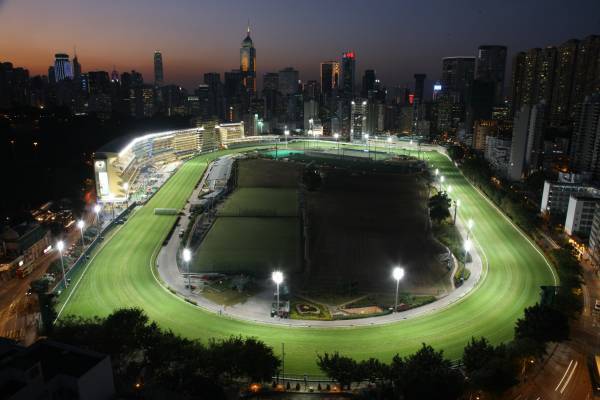Original URL: https://www.theregister.com/2013/04/02/hong_kong_happy_valley_behind_scenes/
Hi-tech horses racing: how to stay Happy down in the Valley
Reg hack takes a punt on tech at Hong Kong’s iconic racecourse
Posted in On-Prem, 2nd April 2013 07:30 GMT
Hong Kongers love to gamble. It’s a serious business over here, and one that can generate at least HK$100m (£8.5m) in turnover from every race.
That money goes to the Hong Kong Jockey Club, a venerable institution formed by the British in 1884 to promote horse racing, which has a monopoly on betting in the city-state.
Every season, from September to July, the Club hosts hundreds of races, with nearly six million bets processed on a typical day – an environment which creates its own unique challenges around managing massive amounts of real time racing data and betting transactions securely and efficiently.
Happy Valley is a place of sensory overload. On Wednesday evenings during the racing season locals flock to the venerable venue – first established here by the British on a cholera-infested swampland back in 1845 – in their thousands to make a fortune. Make no mistake, gambling is serious stuff here. The papers are filled with pages of form guides, studied in minute detail by the mainly male, chain smoking “old timers” before each race.
Several giant floodlit stands circle the west side of the ground while Hong Kong’s irrepressible neon-tinged skyscrapers loom large to the north, south and east.

Although The Hong Kong Jockey Club pulled in around H$28bn (£2.4bn) last year, the non-profit is heavily taxed by the government – in fact it is the city’s single largest tax payer, contributing around seven per cent of all taxes collected – so is always on the look-out for ways to make money and attract new customers.
One such scheme was a long-term project to create a “racing entertainment” area at the heart of the world famous Happy Valley ground, designed to attract a new generation of younger race fans who haven’t the time or inclination to study the form for hours on end. At its centre, is the Interactive Best for You (IBU) – the “world’s largest [and so far, only] multi-touch racing entertainment table”.
Hands-on with the IBU
Tucked away on the second and third floor of the Pavilion Stand is Adrenaline, a swish bar and lounge which wouldn’t be out of place in the nearby Lan Kwai Fong nightlife district. As a racing novice, this El Reg hack was the perfect mark to try out the IBU – ably assisted by the charming betting attendants who man the two tables, dispensing racing tips and user info.

The giant table technically allows up to eight users to bet at one time, although the idea is that more can be squeezed in around the sides to make the experience more “social”. The screen itself isn’t built with the kind of touch-technology you’ll see in a smartphone; it uses a “near infrared” system which shoots infrared light above the surface and detects where it is interrupted by a finger. This does mean it can be a little laggy and less responsive than a typical capacitive touchscreen, although that's only going to frustrate the more serious gamblers, who will be doing things the old-fashioned way with newspaper and pen anyway.
Displayed on the table in garish graphics are the runners and riders for the next race along with their odds. A user can drag a number over to his or her own area and then tap one of four icons that appear to find out more info on ability; jockey and trainer; fitness; and draw.
There’s also an option to view live streaming of the paddock area and video clips of the horses in training. Betting is as simple as dragging the chosen horse tab onto one of five icons at the bottom depending on the nature of your bet – “win”, “place”, “quinella” etc. Particularly useful for mathematical dunces like yours truly is a sliding scale which displays the possible win total according to the value of the bet.

After that it’s a case of touching your pre-paid and PIN protected J-Tap smart card – already pre-loaded with money at the cashier area – on one of the readers on the side of the table, collect a printed receipt, and it’s time to settle down and watch that hard-earned cash slip away. If a horse comes in for you, then the card can be touched in at the cashier area and the winnings handed over.
Behind the scenes
While the IBU’s flash user interface grabs all the attention, most of the heavy lifting happens out of sight, according to HKJC’s director of programme management, Scarlette Leung. A reusable Service Oriented Architecture was designed to integrate the front-end IBU tables and video displays with the content management system, workflow controls, contactless smart-card account system, security, and racing stats and odds display.
Data from new and legacy systems including image files, and multi-media content is integrated and managed to provide the near real-time rich content on display, while back end servers support real-time card transactions and continuously update a broad range of information, from the latest odds to race-by-race changes, to historical runner statistics.
The project to get IBU from drawing board to finished product took about three years from start to finish, beginning with a blank sheet of paper back in 2009, Leung explained.
“At that time the iPhone had come out but no iPad so we were pretty advanced in our thinking,” she said. “We established an in-house team, designed the flow of the table, developed a prototype and design requirements, and selected a US partner.”
Leung explained that the biggest technical challenge was in integrating all the various front and back-end elements to the IBU, while from a project management perspective it was in orchestrating a whopping 25 internal units across various parts of the business, IT operations and project and development.
Agile software development methodology was used on the front-end of the IBU while the Waterfall model was followed to cope with the back-end betting transactions and other elements “because we needed a tighter process”, she revealed. With development groups in Hong Kong, US and Latin America, a 24 hour process of feedback and refinement was instituted with cross-functional teams meeting every week to check progress and log issues.
Going mobile
With a full time staff of around 5,000 and four times that number employed part time, the IT team at HKJC has more to worry about than just supporting race day transactions. However, the organisation was reluctant to reveal too much about its unique IT infrastructure for unspecified "sensitivities". It wouldn’t even reveal what percentage of its servers are virtualised, but did comment that it “has not considered deploying cloud technology as customers’ data security and privacy is always the Club’s utmost priority”.
Seeking extra info, The Reg found a release dating back to 2010 showing the Club rolled out SUSE Linux Enterprise Server as the standard OS for its “recent deployments of core information dissemination, integration and access systems” – praising its support for physical and virtual environments.
The Jockey Club has also been a pioneer in the mobile space, launching a Mobile Betting Service app for the iOS and Android devices in 2011 which covers racing, football and lottery-style Mark Six channels. It also launched a hugely popular Race Simulator app in 2012, allowing punters to study racing form in a more interactive way by running the races a day in advanced according to the info available at the time. Within two weeks of launch, the Race Simulator App had become the number one App in Hong Kong’s iTunes Store and in just a few months amassed over 130,000 downloads.
Whatever your moral judgement on gambling, there’s no doubt Happy Valley is an impressively high-tech racecourse. Staff wander around Adrenaline with iPads loaded with race info ready to help out bemused punters, there are QR codes which link to price lists for race day packages, and of course the afore-mentioned IBU set-up and mobile apps. Although HKJC was tight-lipped on future plans, The Reg could certainly imagine seeing the smart card system used more extensively at race grounds as well as an expansion of the betting table set-up. Also, the SOA is reusable and extendable so could technically be used to bring the same simplified betting experience to a mobile app.
It might not quite have the glamour of Royal Ascot or the Gold Cup, but it beats a rainy afternoon at Doncaster. Western bookies and race grounds could do worse than see how things are done down in the Valley.

®